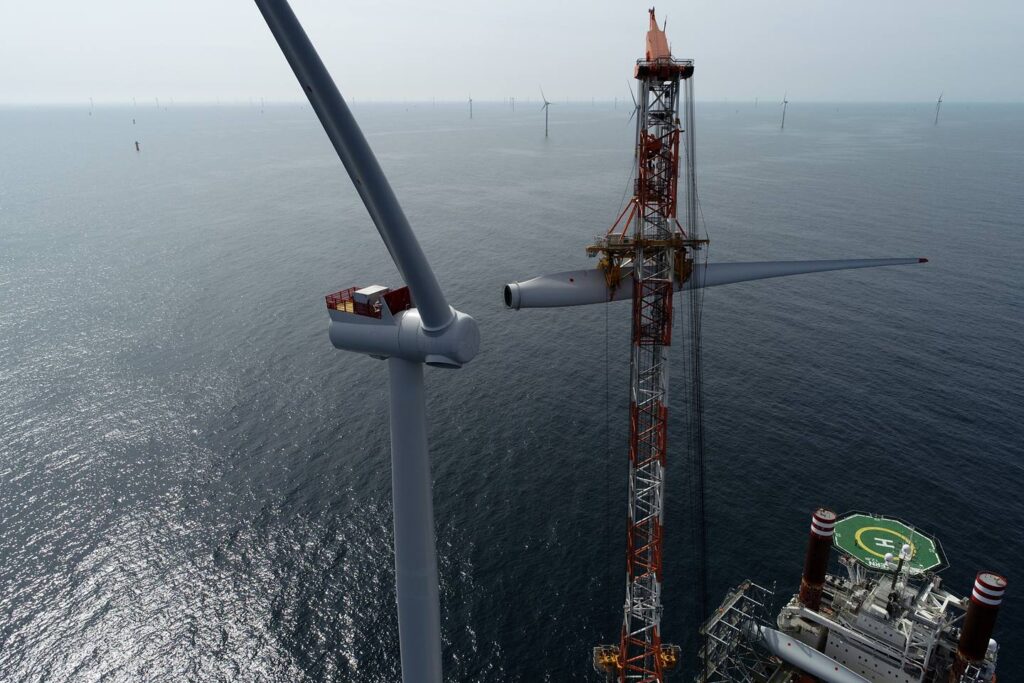By Steve Haner
The company that will partner with Dominion Energy Virginia to build a massive offshore wind farm off our coast has just cut the energy production forecasts for its own facilities, sufficient to lower its profit margins and drop its stock values.
 “Our models weren’t sophisticated enough,” Orsted’s chief financial officer is quoted in one energy industry outlet. Bloomberg’s article, one of many based on the company’s open discussion of the issue yesterday, described the problem this way:
“Our models weren’t sophisticated enough,” Orsted’s chief financial officer is quoted in one energy industry outlet. Bloomberg’s article, one of many based on the company’s open discussion of the issue yesterday, described the problem this way:
The tests show that the company’s current production forecasts underestimate the negative impact from the so-called blockage effect, which arises when the wind slows down as it approaches turbines. It also underestimated the negative effect of the so-called wake effect, in which wind speeds drop between wind parks, it said.
The change will drop what’s called the lifetime load factor to 48%, down from a range of 48%-50%. That figure represents an estimate of how much electricity the machines produce divided by the potential capacity of the turbines. Since the wind doesn’t always blow strongly enough to turn the wind turbine blades, the load factor is always lower than capacity.
The number seems small, but for a giant windfarm like Orsted’s Hornsea One off the east coast of England, a change could shift income by 10s of millions of dollars every year, according to an analysis by BloombergNEF.
“2% is a big deal,” said Tom Edwards, an analyst at Cornwall Insight. “Over the lifetime that’s a lot of energy.”
Yes, a big deal. It will be a lot of lost energy from the Virginia project, as well, over a 30 or 40-year lifetime. Exactly what capacity factor has been promised to Dominion and the Northam Administration is unknown, but if it was 50% and is now 48%, that is actually a four percent reduction. It does change all the financial equations substantially.
The Financial Times picked up on another point:
As a result, Orsted cut its forecast rate of return for seven of its largest offshore wind projects under construction, reducing the lifecycle internal rate of return for these projects from about 8 per cent to about 7.5 per cent. “We do see a couple of effects that we believe will have more of a negative drag on production than we forecast,” said Henrik Poulsen, chief executive of Orsted, calling the change in guidance a “relatively small adjustment”.
Fifty basis points of lower return on investments of that size is a small adjustment? Wrong. As previously noted, the stock markets didn’t agree and knocked down Orsted and others in the field on the news.
That’s no problem for Dominion, of course. The way its deal is proposed to be structured, as best we know to date, the rate of return will be the fixed profit margin the utility enjoys across its capital rate base, plus a 100-basis point reward for its green virtue. That will be far above 8% and probably above 10%. All the performance risk is on the ratepayers, including the risk that five, ten or fifteen years in these capacity factors begin to erode further, or storm damage takes the project offline for a long period.
As with my story last week on Governor Ralph Northam’s warning shot over electricity retail choice legislation, this news is not going to get much attention in Virginia unless somebody pushes. I’m sure the reply will be this is of minor importance. Democratic dreams of glory depend on waves of environmentally inspired voters rushing the gates of the Emerald Commonwealth, and the harsh reality of what is really coming – the same old tilted regulatory structure and accelerating customer costs — will be clear only after the votes are counted.



